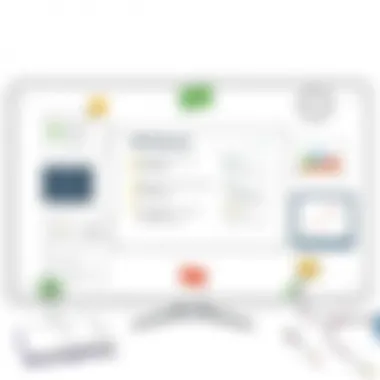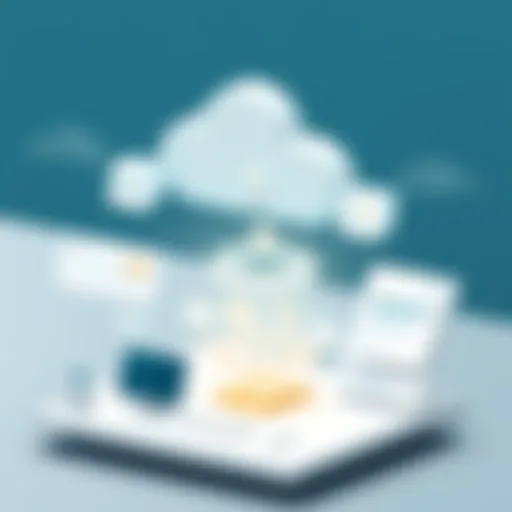In-Depth Review of Whiteboarding Software Solutions


App Overview
In today's fast-paced digital environment, whiteboarding software has emerged as a critical tool for promoting creativity and collaboration. These platforms allow users to brainstorm ideas, visually map out concepts, and facilitate seamless communication during meetings or projects. Whether you're a product manager sketching out a new feature, a teacher explaining complex theories, or a team leader strategizing for a marketing campaign, whiteboarding software serves as a versatile canvas to bring thoughts to life.
Intro to the App and Its Main Features
Imagine a digital space where brainstorming can take flight without the boundaries of traditional whiteboards. That’s the magic of whiteboarding software. These applications come loaded with tools that not only let users draw and write freely, but also incorporate shapes, sticky notes, and image uploads for a lively experience. Features often include:
- Real-time collaboration: Users can interact simultaneously, posting comments and making edits, ensuring that everyone’s voice is heard in the flow of ideas.
- Templates and assets: Most platforms offer pre-designed templates for various purposes, allowing users to dive in without starting from scratch.
- Cross-platform integration: Compatibility with other software like Slack, Google Drive, and Microsoft Teams enhances utility by ensuring that teams can work within their existing ecosystems.
Key Functionalities and Benefits of the App
The benefits of utilizing whiteboarding software extend beyond mere functionality. They transform how teams engage with each other and their projects. The fundamentals include:
- Enhanced creativity: Visually interacting with concepts often prompts innovative thinking and less conventional solutions.
- Documentation and storage: Many apps automatically save whiteboards, providing a record of discussions and decisions for future reference.
- Accessibility: Being cloud-based, these platforms are available anytime, anywhere, catering to remote and on-site teams alike.
Ultimately,
Whiteboarding software acts as a bridge, connecting ideas and individuals, thereby fostering a collaborative environment where creativity thrives.
For an example of how this works, consider Miro, known for its expansive toolkit and user-friendly interface, or Microsoft Whiteboard, favored for its integration with Office 365. Understanding their unique selling points will help both novice and experienced users find the right tool for their needs.
Preface to Whiteboarding Software
In today's fast-paced digital age, whiteboarding software has become an essential tool across a multitude of sectors. Its rise can be attributed to the growing need for collaborative solutions that transcend physical boundaries. Whether it's a tech startup brainstorming for their next big project or a remote team trying to visualize their ideas, whiteboarding solutions provide the means to diagram, share, and innovate collectively. This is not merely about drawing lines on a screen; it's about fostering creativity and enhancing communication.
Key benefits include real-time collaboration, which allows team members from different locations to contribute simultaneously, ensuring that ideas are captured fresh and efficiently. Moreover, the interactive nature of these tools promotes dynamic engagement, igniting a synergy that often leads to innovative breakthroughs. Additionally, many platforms facilitate integrations with other productivity tools, seamlessly fitting into existing workflows and enhancing overall productivity.
To understand the concept more thoroughly, it’s crucial to delve into two fundamental aspects: 1) defining what whiteboarding software is and its intended purpose, and 2) exploring the historical roots that have shaped its evolution. Both elements contribute significantly to understanding its current applications and future potential in a world that increasingly values collaboration and creativity.
Definition and Purpose
Whiteboarding software serves as a virtual equivalent of a traditional whiteboard, but it brings a host of advanced functionalities. At its core, it allows users to create diagrams, flowcharts, and sketches that can be manipulated in real-time. Its primary purpose is to facilitate brainstorming sessions among teams, where ideas can be visually represented and freely modified. Think of it as a digital canvas where creativity knows no bounds, fostering an environment where each participant can express their thoughts without fear or limitation.
One of the standout features is the ability to save and share these sessions, allowing for thoughts and concepts to be revisited and refined later. With capabilities ranging from sticky notes to complex data visualizations, whiteboarding software transforms abstract ideas into concrete visuals, making them easier to understand and act upon.
Historical Context
The concept of whiteboarding isn’t new; it has roots tracing back to traditional physical boards used in classrooms and offices. However, the transition to digital platforms began in earnest in the late 1990s and early 2000s.
Early entrants into the market offered basic functionalities, often limited by the technology of their time. As internet speeds increased and graphic capabilities improved, these tools evolved significantly. Companies like Microsoft and Google began incorporating collaborative features, enabling remote users to interact in real time.
By understanding this historical context, it becomes clear how whiteboarding software has adapted to meet ever-changing user needs in an increasingly digital landscape. Today, they are not only tools for brainstorming but also integral parts of project management and team collaboration strategies. As technology continues to progress, the evolution of whiteboarding software will likely follow suit, opening up new avenues for creativity and collaboration.
Key Features of Whiteboarding Software
Whiteboarding software has revolutionized the way teams brainstorm, plan, and execute projects. Understanding its key features is imperative for anyone looking to enhance collaboration and productivity. These tools are not just digital replacements for physical whiteboards; they come packed with functionalities that cater to various needs in different sectors. The value of leveraging these features can significantly increase a team's efficiency and creativity.
Interactive Canvas
The interactive canvas serves as the heart of whiteboarding software. This feature allows users to create a visual workspace where ideas and concepts can be mapped out in real time. Unlike traditional boards, an interactive canvas enables multiple users to simultaneously draw, write, and manipulate elements, providing a dynamic atmosphere conducive for collaboration. Its flexibility mimics the ease of doodling on a notepad but amplifies it to accommodate intricate designs or detailed plans.
Key aspects of the interactive canvas include:
- Infinite Space: Users can zoom in and out, facilitating detailed work without the constraints of paper. This expanded area enables complex ideas without running out of room.
- Intuitive Navigation: Most platforms ensure smooth navigation, allowing users to transition from one part of the board to another seamlessly, making the creative flow uninterrupted.
- Versatile Formats: Whether sketching diagrams, charts, or simple notes, the interactive canvas supports diverse formats, giving teams the freedom to express their ideas visually.
This feature is crucial, as it embodies user-friendliness and universal access, accommodating various skill levels.
Real-Time Collaboration
In the fast-paced world we now navigate, real-time collaboration emerges as a necessity, especially in remote settings. Good whiteboarding software makes it possible for team members to contribute simultaneously, which is fundamental in fostering collective creativity and decision-making.
Consider the following benefits of this feature:
- Instant Feedback: Team members can provide suggestions or amendments right away, significantly speeding up the review process.
- Geographic Independence: Real-time capabilities mean that teams separated by distance can work as if they are in the same room. This is a game changer for companies with a diverse workforce spread across multiple locations.
- Enhanced Engagement: As participants can see each other’s contributions immediately, it keeps everyone actively involved, reeling in those who might otherwise drift away.
This interconnectedness, fueled by technology, breaks down traditional barriers and enables a more unified approach to problem-solving.


Variety of Tools
Whiteboarding software is packed with an impressive variety of tools designed to cater to diverse tasks. Whether a team needs to create complex diagrams, jot notes, or map out workflows, there are tools available to accomplish these tasks effectively.
The essential tools typically found in these applications include:
- Sticky Notes: Perfect for brainstorming sessions or quick reminders, these digital notes can be moved around freely, making it easy to prioritize tasks.
- Drawing Tools: A selection of shapes, lines, and colors allows users to create custom visuals that can better convey their ideas.
- Text Inputs: Easy-to-use text tools empower users to add descriptions, labeling, or commentary directly onto the canvas, enhancing clarity and context.
These tools cater to a range of methodologies, allowing teams from agile software development to educational settings to tailor their boards to maximize effectiveness.
Cloud Storage Integration
The integration of cloud storage solutions within whiteboarding software is essential for any organization prioritizing ease of access and data security. Having the ability to store, retrieve, and share boards effortlessly can greatly enhance workflows.
Benefits of this integration include:
- Accessibility: Team members can access their boards from any device with internet connection. This freedom allows for continuity, even when on the go.
- Collaboration: When boards are saved in the cloud, it simplifies sharing with external clients or teams, ensuring everyone is working from the latest version.
- Backup and Safety: Storing materials in the cloud provides peace of mind. No one wants to lose hours of hard work because of a hardware failure.
Emphasizing cloud integration within the software helps foster an environment where collaboration thrives without the fog of version control issues.
This exploration of features sets the stage for a deeper dive into the benefits that come from utilizing whiteboarding applications.
Benefits of Using Whiteboarding Software
In the fast-paced landscape of modern work environments, the ability to communicate ideas and collaborate effectively stands as a cornerstone for success. Whiteboarding software has emerged as a powerful tool in this context, offering a digital canvas where creativity, clarity, and project management converge. The importance of harnessing these tools cannot be overstated, especially when teamwork is at stake. Here, we break down the key benefits of using whiteboarding software into three pivotal aspects: enhancing creativity, improving communication, and streamlining project management.
Enhancing Creativity
When it comes to brainstorming sessions, the ability to visualize thoughts can make a world of difference. Whiteboarding software fosters an atmosphere where creativity can flourish without traditional constraints. Imagine a virtual space where team members can drop ideas like confetti: sketches, text labels, sticky notes—all in real-time. This dynamic allows individuals to build on each other's concepts, sparking innovations that might not surface in a conventional meeting.
- Mind Mapping: Unrestricted brainstorming helps in developing a web of ideas that can lead to breakthrough solutions.
- Diverse Templates: Many platforms offer templates tailored for specific projects, which can guide the creative process rather than hinder it.
- Visual Elements: Integration of images, drawings, and graphics allows for a rich tapestry of information that engages all participants.
Using software like Miro or Microsoft Whiteboard, users can literally draw their vision, turning abstract ideas into tangible plans. It's not just about making pretty presentations; it's about creating a collaborative space that feels alive and reactive.
Improving Communication
Communication can be the make-or-break factor in any project. Whiteboarding tools enable clearer dialogue among team members by giving everyone a space to present their ideas visually. Instead of deeply nested email threads or lengthy documents, a shared board offers a panoramic view of what's being discussed or worked on. Here’s how it enhances communication:
- Visual Feedback: Team members can place comments directly on the board, allowing for immediate feedback without disrupting the flow of ideas.
- Unified Perspective: Everyone sees the same visual representation, which reduces the chances of miscommunication or differing interpretations of an idea.
- Real-Time Updates: Changes made by any participant are visible to all in real-time. This keeps everyone in sync, making it easier to adjust plans as discussions unfold.
Moreover, these tools often integrate with other communication platforms, allowing seamless transitions between discussions and visual brainstorming.
Streamlining Project Management
In the realm of project management, whiteboarding software can act as a conductor, orchestrating complex tasks and timelines into a cohesive symphony. Here are some of the ways it simplifies management:
- Task Breakdown: Users can visually map out the stages of a project, dividing major tasks into smaller, manageable actions that can be assigned to team members.
- Tracking Progress: With visual checklists and timelines, it’s easier to monitor progress and identify potential roadblocks before they escalate.
- Resource Allocation: Teams can map dependencies and resource allocations visibly, which helps clarify who is doing what and when.
"The right tools foster an environment where efficiency meets creativity. Whiteboarding software is at the intersection of those two."
By leveraging the capabilities of these digital platforms, organizations can expect smoother project flows, enhanced accountability, and perhaps most importantly, a more engaged team.
Leading Whiteboarding Software on the Market
The landscape of whiteboarding software continues to evolve as teams look for innovative solutions to enhance collaboration, communication, and project management. In this section, we will explore several leading platforms that have made a significant impact on the market. Each of these tools offers unique advantages and functionalities that cater to diverse user needs. Understanding their strengths can help organizations make informed choices, streamlining workflows while bolstering creative output.
Miro: A Collaborative Giant
Miro stands tall as one of the most recognized names in whiteboarding software. Its user-friendly interface and vast array of templates allow teams to jump right in and start brainstorming or strategizing without missing a beat. Users can unleash their creativity with sticky notes, shapes, and connections to visualize ideas in real time.
With features like video chat and integrated comments, Miro enhances remote collaboration, putting everyone on the same page, regardless of their physical location. Its integrations with tools such as Slack, Google Drive, and Jira make it a versatile option for tech-savvy teams who rely on multiple apps throughout their day. The platform encourages free-flowing idea generation, making it ideal for design sprints and planning sessions.
Microsoft Whiteboard: Integration with Ecosystem
Fitting snugly into the Microsoft ecosystem, Microsoft Whiteboard shines for users deeply embedded in Microsoft’s suite of applications. This digital whiteboard offers an infinite canvas where ideas can flourish. Users can take advantage of features like drawing tools, text notes, and images, enabling seamless collaboration among team members.
One notable highlight is how it integrates with Teams and OneNote, creating a cohesive workspace that fits naturally into existing workflows. Teams can easily share ideas and sketches during meetings or brainstorming sessions without flipping between different applications. This convergence fosters a smooth experience for both novices and seasoned pros alike.
Jamboard: Google's Contribution


Google's Jamboard is a robust offering that combines the best elements of traditional whiteboarding with digital prowess. It’s particularly beneficial for organizations that already leverage Google Workspace, as it enables real-time collaboration within a familiar environment.
Jamboard features a unique approach with its touchscreen capabilities, allowing users to interact with their content physically. Users can draw or write and see their changes update instantly for all session participants. It stands out through its integration with Google Drive, making it easy to store and retrieve files, access images, and collaborate on projects without missing a beat.
Lucidchart: Diagrammatic Focus
Lucidchart, while more diagrammatically focused, also provides an effective whiteboarding experience. Targeting teams that need to create process flows and organizational charts, Lucidchart gives users the tools to visualize complex information clearly.
Collaborative features like real-time editing and comment threads make discussions more productive. Users can easily share links to their diagrams or export them into various formats. With integration capabilities spanning across tools like Confluence and Slack, Lucidchart ensures that visual communication remains a core component of any project.
In summary, the variety of leading whiteboarding software on the market caters to diverse teams and their needs. Understanding the specifics of each platform helps in selecting the right tool to enhance collaboration and productivity effectively.
"Choosing the right whiteboarding solution is essential for maximizing team performance and creativity in today's fast-paced work environment."
For more in-depth understanding, consider exploring resources from Wikipedia and Britannica for additional insights.
Comparative Analysis of Top Platforms
In today's rapidly developing tech landscape, the selection of the right whiteboarding software can significantly sway a team's productivity and creative output. Understanding the comparative strengths of various platforms allows teams to align their specific needs with the software capabilities. This section peels back the layers on several leading options, highlighting what set them apart while offering insight into the priorities that teams should consider when making a decision.
Feature Comparison
When it comes to whiteboarding software, features are the name of the game. Each platform brings its own unique set of functionalities. For instance:
- Miro tends to excel in its extensive template library, which simplifies the brainstorming process. Users can quickly choose from frameworks that enhance productivity.
- Microsoft Whiteboard shines through its tight integration with other Microsoft tools, facilitating a seamless workflow for teams already embedded in that ecosystem.
- Jamboard by Google offers intuitive tools that make it easy for teams to collaborate in real-time, especially beneficial in educational settings.
- Lucidchart stands out with its advanced diagramming capabilities, making it a go-to for those who focus heavily on visual representation of data.
The choice ultimately aligns with what a user's primary focus is; whether it's collaboration, design, or project management.
Pricing Models
Pricing often dictates which software a team decides to adopt. It's essential to explore several pricing models:
- Free Tier: Many platforms, such as Miro and Jamboard, offer free versions that provide sufficient features for startups and small teams looking to experiment with whiteboarding solutions without incurring upfront costs.
- Subscription Plans: Regular payments can lead to enhanced features. Microsoft Whiteboard offers various plans based on team size and usage.
- One-time Purchase: Some platforms might require a single payment for a perpetual license, which can be attractive for established companies not wishing to commit to ongoing fees.
Being aware of these models helps teams calculate total cost versus gain in functionality, ensuring fiscal responsibility.
User Experience Assessment
User experience stands at the forefront of any software evaluation. In this context, examining how easy it is to navigate these platforms becomes crucial:
- Intuitive Design: Programs like Miro and Jamboard have invested significantly in ensuring a user-friendly interface, allowing even those with minimal tech skills to dive in without much prior knowledge.
- Onboarding Resources: Teams appreciate robust onboarding processes, including tutorials and help centers that significantly reduce the learning curve. Lucidchart excels here, providing users with instructional videos and how-to guides.
- Community Support: Platforms like Microsoft Whiteboard benefit from extensive online forums and community support, making it easier for users to troubleshoot issues as they arise.
Assessing the user experience not only reflects on product design but impacts overall team satisfaction and productivity.
"Selecting the right whiteboarding software isn’t just about choosing a tool; it’s about ensuring a smoother workflow and better end results."
In summary, this comparative analysis guides users through the complex landscape of whiteboarding software, assisting teams in making informed choices based on specific needs, financial considerations, and user experience.
User Considerations When Choosing Software
Selecting the right whiteboarding software is a crucial step for any team aiming to optimize their collaborative efforts. This process goes beyond simply picking the most popular tools on the market. It's about understanding specific needs and ensuring that the selected software aligns perfectly with team objectives. The landscape of whiteboarding software is diverse, and tailoring choices to the unique requirements of a team can significantly enhance productivity and ease of use.
Assessing Team Needs
It's essential first to gauge what the team really needs from whiteboarding software. Are they mainly focused on brainstorming sessions, or do they require more intricate project management functionalities? Engaging with the team members can shine a light on individual preferences and needs, which ultimately aids in making an informed choice.
- Gather Input: Create a survey or hold a meeting allowing everyone to voice their opinions. Questions could revolve around what features they prioritize, like ease of use or advanced capabilities. Sources like Facebook Surveys or Google Forms can be handy tools for this.
- Define Objectives: A clear understanding of what the team aims to achieve helps. If the goal is to innovate and generate creative ideas, simpler tools might suffice. However, for complex project workflows, a more feature-rich platform would be beneficial.
- Flexibility and Scalability: Consider whether the software can evolve with your team. As projects grow or your team expands, it is vital to select a solution that can scale without exorbitant costs or disruptions.
By prioritizing these areas, teams position themselves to make a more aligned decision that boosts overall effectiveness.
Understanding Integration Options
Once team needs have been assessed, the next step is to explore how well potential whiteboarding systems mesh with existing tools and workflows. Integration options can make or break a user experience, impacting everything from ease of use to overall productivity.
- Check Compatibility: Whether it’s with project management tools like Trello or communication platforms like Slack, ensure that your choice integrates smoothly with the software already in use. Many modern solutions offer plugins or APIs that facilitate this process.
- Centralized Workflow: A unified workspace fosters better collaboration. Some tools enable documents, calendar functions, and email notifications to sync in real-time, allowing for a seamless experience.
- Testing Integrations: Before finalizing, consider using trial versions of the software to test integration capabilities. This hands-on approach reveals how well the tools work together in a practical setting.
Effective integration options can serve as the glue that holds diverse aspects of a project together, making everything run like a well-oiled machine.
Ultimately, understanding both team needs and integration options empowers organizations to choose whiteboarding software that not just fits but enhances their collaborative endeavors.


Best Practices for Effective Use
In the evolving landscape of whiteboarding software, employing best practices becomes essential for deriving maximum value from these tools. Whether you are a project manager directing a team effort or an educator engaging with students, knowing how to effectively utilize whiteboarding software can transform your collaboration and productivity. Implementing these practices can bridge communication gaps, enhance creativity, and ensure that your projects stay on course.
Setting Objectives
The first step in engaging with any whiteboarding software is to clearly define your objectives. It’s like sailing; you wouldn’t set out to sea without knowing your destination. Determine what you aim to achieve with the session, whether it's brainstorming ideas, mapping out projects, or teaching a concept. Here’s how to ensure your objectives are well established:
- Be Specific: General goals often lead to vague outcomes. Instead of saying, “Let’s brainstorm,” try “We aim to generate at least ten actionable ideas for our marketing strategy.”
- Align with Team Goals: Make sure everyone's objectives align with the overarching goals of the team or organization. This fosters unity and focus.
- Communicate Clearly: Share these objectives ahead of time with participants to set expectations. When everyone knows the target, they are more likely to hit it.
"Setting clear goals is the first step in turning the invisible into the visible."
- Tony Robbins
Encouraging Participation
Once objectives are set, the next challenge is to foster an engaging environment where participation flourishes. It’s not enough to have a tool; you need buy-in from all participants. Here are strategies for involving everyone:
- Use Icebreakers: Start with a fun icebreaker or warm-up activity. This helps people loosen up and get into the collaborative spirit.
- Active Facilitation: As a leader or organizer, actively encourage inputs from all members. Consider using features within the software that allow users to vote on ideas or contribute anonymously, which can spur contributions from quieter members.
- Visual Engagement: Leverage the variety of tools within the software—stickers, shapes, and colors—to make engagement visually stimulating. Visuals can draw people in and make sessions more enjoyable.
Evaluating Outcomes
Finally, after the dust has settled, evaluating the outcomes of your whiteboarding session is crucial. This is the reflective piece where you can measure success against the objectives you set. Here’s how to approach it:
- Review Session Outcomes: Gather feedback from all participants about the session's effectiveness. What worked? What didn’t? This will offer valuable insights for future sessions.
- Documentation: Make sure to document the outcomes from your session. Keeping a record helps in tracking progress on projects, and maintaining accountability.
- Iterate and Improve: Use the feedback to refine your tactics. Whiteboarding software is versatile, and tweaking your approach can lead to better outcomes in subsequent uses.
Assessing these various aspects not only enhances the functionality of whiteboarding software but also leads to continuous improvement in team collaboration and project success. Taking the time to set clear objectives, encourage participation, and evaluate results ensures that you are getting the most from your tools, helping you navigate the journey towards achieving your goals.
Future Trends in Whiteboarding Software
As the landscape of technology evolves, whiteboarding software is set to undergo significant transformations, reflecting the changing needs and expectations of its users. These future trends are not only pivotal for enhancing collaborative experiences but also for integrating advanced functionalities that can redefine teamwork dynamics across various industries. The evolution of such software can boost creativity, streamline processes, and enrich user engagement. Let's dive into the anticipated trends that promise to shape whiteboarding software in the years to come.
Artificial Intelligence Integration
Integrating Artificial Intelligence (AI) into whiteboarding software is foreseen as a cornerstone for the future. With AI capabilities, platforms can offer smart suggestions, automated content organization, and more. Imagine sketching an idea on a virtual board and immediately receiving prompts for related concepts or tools that could help express that idea more vividly. This kind of advanced functionality could make users feel more empowered and ensure that every brainstorming session leads to actionable outcomes.
Moreover, AI can facilitate automated summarization of discussions held on the board. Users no longer need to manually jot down key points during meetings; instead, AI can capture ideas and insights, creating a cohesive summary for participants. This reduces the cognitive load, allowing teams to focus more on creativity rather than documentation.
In addition, intelligent algorithms can analyze user interaction data to personalize the experience, tailoring recommendations based on past behavior and preferences. By predicting what tools or features users may need, AI enhances productivity, ensuring that the user experience is both intuitive and seamless.
Augmented and Virtual Reality Applications
Augmented Reality (AR) and Virtual Reality (VR) technologies are poised to revolutionize how whiteboarding software is utilized. As more people work remotely, these immersive technologies provide an alternative to traditional brainstorming sessions. In a virtual setting, team members from different locations can meet in a simulated environment, interacting with ideas and visuals as if they were present in the same physical space.
Utilizing VR applications, teams can create fully interactive 3D models or environments on a whiteboard, allowing complex ideas to be visualized in a more tangible way. This can benefit industries such as architecture, engineering, and design, where spatial relationships and dynamics are fundamental to project success.
AR applications, on the other hand, allow users to superimpose digital elements onto their physical workspace. For example, a business team might devise strategies on their smart device while pointing it at a physical surface, viewing the results in real-time. This blend of digital and physical provides an innovative way to engage with content, enhancing creativity and participation among team members.
In summary, certain trends like AI integration and immersive technologies are expected to significantly alter the features and capabilities of whiteboarding software. Embracing these changes will not only improve efficiency and collaboration but also foster an environment where idea generation can thrive in novel ways.
Exploring these trends can be essential for developers looking to innovate further and for organizations aiming to remain competitive in a tech-driven world. Whether one is adapting to these developments or proactively leveraging them, the future of whiteboarding software certainly presents a multitude of exciting possibilities.
Closure
The concept of whiteboarding software has emerged as a valuable asset across multiple fields, emphasizing collaborative efforts and increasing productivity. Understanding the various aspects covered in this article proves crucial for businesses and creative teams alike.
Recap of Insights
In this final section, let’s distill the core revelations presented earlier. Whiteboarding software offers a unique blend of versatility, allowing users to brainstorm ideas freely and visualize plans effectively.
- Interactive Canvas: Users can draw, annotate, and organize thoughts on a single platform, making it easier to conceptualize projects.
- Real-Time Collaboration: Multiple participants can contribute simultaneously, making team discussions seamless whether in-person or remote.
- Diverse Tools: From sticky notes to templates, the assorted tools help tailor the workspace for specific projects.
- Cloud Storage: This integration means that ideas and notes are always accessible, promoting continuity and collaboration.
Through these insights, it’s clear how critical this technology can be in enhancing communication and boosting creativity. Leveraging whiteboarding platforms enables teams to unite their ideas into coherent strategies.
Final Thoughts on Adoption
As organizations ponder the adoption of whiteboarding tools, several considerations come into play. Firstly, the commitment to improving team interactions is paramount. As highlighted, a digital whiteboard bridges gaps that might exist in traditional brainstorming methods. It’s a modern approach to an age-old process of conceptualizing ideas.
Additionally, understanding team-specific needs is vital. Not all platforms cater to the same demands; thus, assessing usability based on project scope and team size is essential. For instance, smaller teams might benefit from simpler tools, while larger corporations may require robust functionalities like integration with existing software.
"Adopting whiteboarding software isn't just about buying a tool; it's about embracing a culture of collaboration."
Ultimately, being open to adopting such innovative solutions can significantly yield benefits in project management, interaction capabilities, and the overall creative process. It’s not merely a trend but a step toward a more connected, cohesive work environment.
For further reading on whiteboarding solutions, consider exploring resources from Wikipedia on Team Collaboration, the various discussions on platforms like Reddit that focus on user experiences, or even testimonials found on Google Products.





